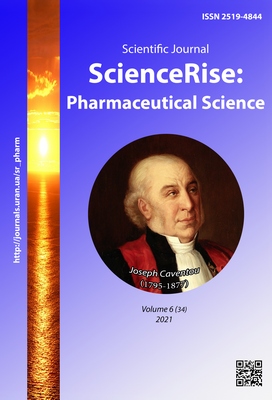Comparative study the essential oil composition of flowers and leaves of Crataegus monogyna L.
DOI:
https://doi.org/10.15587/2519-4852.2021.249276Keywords:
hawthorn, leaves, flowers, essential oil, quantitative content, chemical compositionAbstract
The aim of the work was to obtain essential oil from the leaves and flowers of the genus Hawthorn Crataegus monogyna L. and study its component composition to justify the possibility of expanding the use of this herbal drugs in medicine.
Materials and methods. The leaves and flowers of Сrataegus monogyna L., which were used to obtain essential oil, were harvested in the western region of Ukraine in 2019. The quantitative content of essential oil in the herbal drugs was determined by hydrodistillation. By used chromato-mass spectrometry method determined the component composition of essential oil of leaves and flowers of Сrataegus monogyna L. The obtained spectra were compared with the library of mass spectra NIST05 and WILEY 2007 with a total number of spectra over 470000 in combination with programs for identification AMDIS and NIST.Results. The essential oil of leaves and flowers of Сrataegus monogyna L. was obtained and its quantitative content was determined, which was 0.15±0.02 % for flowers and 0.11±0.03 % for leaves. By used chromato-mass spectrometric method in the essential oil of flowers of Сrataegus monogyna L. revealed 37 compounds, leaves – 33. In the essential oil of flowers found monoterpenoids, the content of which was 0.44 % of the total, triterpenoids 7.17 %, aromatic compounds 12.61 %. In the essential oil of leaves were found monoterpenoids 37.8 %, aromatic compounds 10.25 %, norterpenoids 3.62 %, sesquiterpenoids 4.02 %, diterpenoids 2.17 %, triterpenoids 5.08 %.Conclusions. Due to the defined component composition of the essential oil of flowers and leaves of Сrataegus monogyna L., we consider its use to create drugs of external action for the treatment of skin diseases of various etiologies caused by staphylococcal and fungal microflora.
References
- Derzhavna Farmakopeia Ukrainy (2016). Kharkiv: Derzhavne pidpryiemstvo «Ukrainskyi naukovyi farmakopeinyi tsentr yakosti likarskykh zasobiv», 360.
- European Pharmacopoeia. Vol. 1 (2010). Strasbourg: Council of Europe, 3307.
- Rababa’h, A. M., Al Yacoub, O. N., El-Elimat, T., Rabab’ah, M., Altarabsheh, S., Deo, S. et. al. (2020). The effect of hawthorn flower and leaf extract (Crataegus Spp.) on cardiac hemostasis and oxidative parameters in Sprague Dawley rats. Heliyon, 6 (8). doi: http://doi.org/10.1016/j.heliyon.2020.e04617
- Sydora, N. V., Kоvaleva, A. M., Iakovenko, V. K. (2016). Phytochemical research of Crataegus submollis Sarg. leaves lipophilic complex and study of its antibacterial activity. Der Pharmacia Lettre, 8 (21), 19–23.
- Halver, J., Wenzel, K., Sendker, J., Carrillo García, C., Erdelmeier, C. A. J., Willems, E. et. al. (2019). Crataegus Extract WS®1442 Stimulates Cardiomyogenesis and Angiogenesis From Stem Cells: A Possible New Pharmacology for Hawthorn? Frontiers in Pharmacology, 10. doi: http://doi.org/10.3389/fphar.2019.01357
- Wang, X., Liang, Y., Shi, J., Zhu, H., Bleske, B. (2018). Crataegus Special Extract WS 1442 Effects on eNOS and microRNA 155. Planta Medica, 84 (15), 1094–1100. doi: http://doi.org/10.1055/a-0601-7083
- Khokhlova, K. O., Zdoryk, O. A., Sydora, N. V., Shatrovska, V. I. (2019). Chromatographic Profiles Analysis of Fruits of Crataegus L. Genus by High-Performance Thin-Layer Chromatography. European Pharmaceutical Journal, 66 (2), 45–51. doi: http://doi.org/10.2478/afpuc-2019-0020
- Abuashwashi, M. A., Palomino, O. M., Gómez-Serranillos, M. P. (2016). Geographic origin influences the phenolic composition and antioxidant potential of wildCrataegus monogynafrom Spain. Pharmaceutical Biology, 54 (11), 2708–2713. doi: http://doi.org/10.1080/13880209.2016.1179769
- Belabdelli, F., Bekhti, N., Piras, A., Benhafsa, F. M., Ilham, M., Adil, S., Anes, L. (2021). Chemical composition, antioxidant and antibacterial activity of Crataegus monogyna leaves’ extracts. Natural Product Research, 1–6. doi: http://doi.org/10.1080/14786419.2021.1958215
- Lis, M., Szczypka, M., Suszko-Pawłowska, A., Sokół-Łętowska, A., Kucharska, A., Obmińska-Mrukowicz, B. (2019). Hawthorn (Crataegus monogyna) Phenolic Extract Modulates Lymphocyte Subsets and Humoral Immune Response in Mice. Planta Medica, 86 (2), 160–168. doi: http://doi.org/10.1055/a-1045-5437
- Rababa’h, A. M., Altarabsheh, S. E., Haddad, O., Deo, S. V., Obeidat, Y., Al-Azzam, S. (2016). Hawthorn Herb Increases the Risk of Bleeding after Cardiac Surgery: An Evidence-Based Approach. The Heart Surgery Forum, 19 (4), 175–179. doi: http://doi.org/10.1532/hsf.1570
- Kuhn, T., Jancso, B., Ruprecht, E. (2021). Hawthorn (Crataegus L.) Taxa and their hybrids in North-Western Romania: a recommendation for national identification keys based on morphometric analyses. Contribuţii Botanice, 55, 7–26. doi: http://doi.org/10.24193/contrib.bot.55.1
- Phipps, J. B. (2016). Studies in Mespilus, Crataegus, and ×Crataemespilus (Rosaceae), II. The academic and folk taxonomy of the medlar, Mespilus germanica, and hawthorns, Crataegus (Rosaceae). Phytotaxa, 260 (1), 25–35. doi: http://doi.org/10.11646/phytotaxa.260.1.3
- Sydora, N. (2018). Morphological and taxonomic study of oxyacanthae Zbl. section of crataegus L. genus by vegetative characteristics. ScienceRise: Pharmaceutical Science, 1 (11), 36–41. doi: http://doi.org/10.15587/2519-4852.2018.124432
- Derzhavna Farmakopeia Ukrainy. Vol. 1 (2015). Kharkiv: Derzhavne pidpryiemstvo «Ukrainskyi naukovyi farmakopeinyi tsentr yakosti likarskykh zasobiv», 1128.
- Chernogorod, L. B., Vinogradov, B. A. (2006). Efirnye masla nekotorykh vidov roda Achillea L., soderzhaschie fragranol. Rastitelnye resursy, 42 (2), 61–68.
- Sydora, N. V., Kоvalova, A. M. (2016). Gas-chromatographic-mass spectrometric studies the volatile compounds and organic acids the leaves of Crataegus macracantha Loud. American Journal of Science and Technologies, 3 (1 (21)), 1041–1045.
- Elshafie, H. S., Camele, I. (2017). An Overview of the Biological Effects of Some Mediterranean Essential Oils on Human Health. BioMed Research International, 2017, 1–14. doi: http://doi.org/10.1155/2017/9268468
- Aljaafari, M. N., AlAli, A. O., Baqais, L., Alqubaisy, M., AlAli, M., Molouki, A. et. al. (2021). An Overview of the Potential Therapeutic Applications of Essential Oils. Molecules, 26 (3), 628. doi: http://doi.org/10.3390/molecules26030628
- Jugreet, B. S., Mahomoodally, M. F. (2020). Pharmacological Properties of Essential Oil Constituents and their Mechanisms of Action. Plant-Derived Bioactives. Singapore: Springer, 387–415. doi: http://doi.org/10.1007/978-981-15-2361-8_18
Downloads
Published
How to Cite
Issue
Section
License
Copyright (c) 2021 Natalia Sydora, Olena Konovalova, Svetlana Zuikina, Kateryna Semchenko, Anna Rudnyk, Iryna Hurtovenko

This work is licensed under a Creative Commons Attribution 4.0 International License.
Our journal abides by the Creative Commons CC BY copyright rights and permissions for open access journals.








